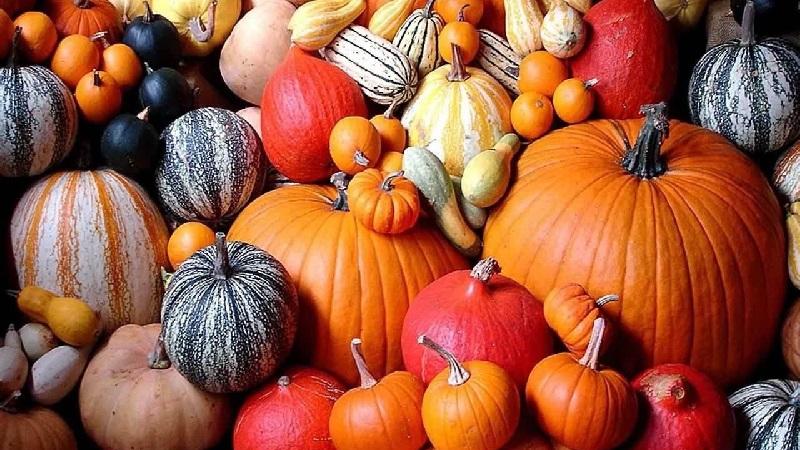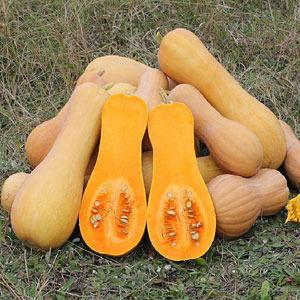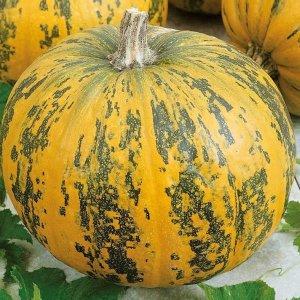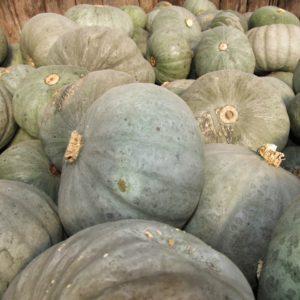Types of varieties of butternut pumpkin: why they are loved and how to achieve a good harvest
It's hard to imagine, but once the pumpkin was used exclusively as a piece of furniture. People had no idea how tasty and healthy this product is. Time passed, and the whole world became aware of the wonderful properties of pumpkin.
Muscat varieties are especially popular as they have a delicate and sweet pulp and mild flavor. Even a novice gardener can grow a nutmeg vegetable. Consider what qualities sweet pumpkins have and how to care for a crop to get a good harvest.
The content of the article
Useful properties of butternut squash
Butternut squash differs from other types in shape and taste. The vegetable is oval and elongated, and not round, as in most varieties. Its skin is thin and can be easily removed even without a knife. Muscat varieties are the sweetest, they taste like melon.
Plus, they have a lot of useful vitamins and elements:
- Vitamins A, E, B6 and B12 have a positive effect on human vision. They help prevent eye diseases and provide excellent health benefits.
- Vitamin T allows you to lose weight: it normalizes metabolism, breaks down fats and converts fat into energy.
- Vitamins C, B1 and B3 are good for men's health. B6 improves the absorption of fatty acids, and vitamin C normalizes the functioning of the prostate gland.
- Vitamins A and E have excellent anti-aging effects. They moisturize the skin, and regular consumption of pumpkin helps to smooth out fine wrinkles and prevent the appearance of new ones.
- Vitamin PP improves protein and fat metabolism, lowers cholesterol and has a vasodilator effect.
In addition, pumpkin is recommended for people who suffer from ulcers of internal organs. Porridges and soups are prepared from the pulp: they have a healing effect on the digestive system. Also, the vegetable restores the acid-base balance in the human stomach, helps to get rid of heartburn and pain.
The product contains a high amount of fiber, which relieves bloating and strong gas formation. It is enough to eat only 50 g of pumpkin every day.
Interesting! The attractive orange color of Muscat varieties is due to the high carotene content. The longer the culture is stored, the richer the color. However, do not store the product for too long, as the amount of vitamins in it decreases over time.

Where and when to grow
The southern regions of the country are best suited for a good harvest. They are distinguished by fertile soil and long warm summers. As a rule, in the south, the crop is grown in the open field.
As for central Russia and the north, in these areas the vegetable is planted in a greenhouse or greenhouse. Buildings help nutmeg varieties survive drastic climatic changes and produce good yields.
Important!The best precursors for planting are peppers, potatoes, or legumes. It is not recommended to plant the plant after cucumbers, squash or zucchini.
Pumpkins love warm, spacious and well-lit areas. Please note that before planting, all debris and weeds are removed from the beds, they dig up and fertilize the soil. For 1 sq. m of land are advised to plant no more than two bushes. Seedlings are prepared 20-25 days before the intended planting in the ground. The landing itself takes place in early May.It is important that the soil temperature is at least 12 degrees.
How to grow
Pumpkin is a thermophilic culture. Caring for her is simple, although it has some features. Consider what should be done to get a tasty and beautiful harvest.
Site selection
For nutmeg varieties, land with a deep arable layer and loose soil is excellent. Many gardeners grow them on compost because it is warm and nutritious. If there is no compost heap, then prepare the beds.
To do this, set aside a warm and sunny place. Previously, the bed is dug up in the fall and all the garbage is burned. With the arrival of spring, the earth is dug up again and disinfected. A solution of copper sulfate is suitable for this. The liquid will destroy dangerous microbes and pathogens.
Also, farmers are advised to apply organic fertilizers. Before planting, an excellent option would be to fertilize the soil with an ash-based infusion. It will make the land more nutritious and healthy for the pumpkin, which will have a positive effect on the quality of the crop.
Seed preparation
When choosing seeds, pay attention to the integrity and appearance of the packaging. We advise you to buy them in specialized stores. Inspect after purchase seed and check for germination. Put them in a container of water and stir in a circular motion. Leave it on for 10 minutes.
Any seeds that remain on the surface should be thrown away because they are empty. Remove those specimens that have sunk to the bottom and carefully dry... They are also suitable for sowing.
Even purchased material is best disinfected. Boric acid is an excellent remedy. It is enough to soak the seeds in a solution at the rate of 0.2 g per 1 liter of water for two hours. The solution protects the pumpkin from fungal infections and increases yields.
Important! Don't forget to germinate your seeds. To do this, place them on a damp cotton pad and place in a warm place. Farmers advise the use of growth stimulants: for example, succinic acid protects against diseases, and sodium humate accelerates growth.
Care and feeding
Water the pumpkin sparingly, with the calculation of no more than 2.5 liters of water per bush. The optimum temperature for watering is about 18-22 degrees. It is best to moisturize the beds in the early morning or evening to avoid sunburn.
In humid and foggy summers, the amount of water is reduced so as not to overmoisten the plant. Sometimes liquid root fertilizers such as a solution of nettle or ash are added to the irrigation.
The beds are loosened every week, best done before watering. Loosening removes the hard top crust of the earth: it makes it difficult to access nutrients. Together with loosening, weeds are removed, which slow down the development of the bushes.
Pumpkin reacts positively to mineral complex fertilizers and organic substances. The most popular among gardeners are:
- "Nutriflex S" - contains magnesium, zinc and calcium, without which the normal development of vegetables is impossible.
- "Zircon" - increases yield by 10-15% and improves plant immunity to diseases and insect pests.
- "Micefit" - strengthens the root system, makes it more developed.
- Chicken droppings - contains nitrogen, potassium and phosphorus, which strengthen the stems and leaves.
- Ash solution - reduces soil acidity and makes the plant easier to tolerate climatic changes. It is especially useful for growing and caring for butternut squash in the open field.

Lash formation
How to shape butternut squash? Lines are formed in mid-August for the early ripening of vegetables. They always reach for the sun, therefore they grow in a southerly direction. On long lashes, 4-5 pumpkins are formed at once, which do not have time to ripen in time.
Select the largest vegetables and tear off the remaining ovary. After each lash, pinch. With the help of the formation, the growth of the bush stops, and all the nutrition goes to the ripening of the pumpkin.
Important! As soon as the length of one lash becomes more than 1 m, it should be straightened and put on the garden bed, sprinkled with earth on top. This is necessary so that long lashes do not injure leaves and stems.
The best varieties of butternut squash
Butternut squash is indispensable for preparing a variety of dishes. Some vegetables are great for sweet but healthy baked goods, while others are a great vegetable side dish. Consider how sweet varieties are more popular in cooking.
Pearl
 The vegetable manifests itself well both in the south of the country and in the middle lane. It can be grown in seedlings or non-seedlings. Pearl - this is a medium late variety, ripening period - 115-120 days from the moment of planting. The bushes are powerful, forming about five long lateral lashes.
The vegetable manifests itself well both in the south of the country and in the middle lane. It can be grown in seedlings or non-seedlings. Pearl - this is a medium late variety, ripening period - 115-120 days from the moment of planting. The bushes are powerful, forming about five long lateral lashes.
Formation of a plant is obligatory. The pumpkins themselves are bright orange and cylindrical pear-shaped. The rind is moderately dense, but not hard. The pearl has a slightly ribbed and rough structure. The pulp is orange and fibrous, the taste is delicate.
One pumpkin is 80 cm long and weighs 4-5 kg. The plant does not tolerate drafts, so it is better to choose a dry and windless area for planting.
The pearl reacts well to mineral fertilizers, which are applied once every 2-3 weeks. Harvested in sunny weather, the vegetable is plucked along with the stalk: this way it is stored longer and does not lose its beneficial properties.
Vitamin
 Late-ripening pumpkin pleases gardeners with large orange fruits. Sometimes dark green spots and slight ribbing appear on the surface. The average weight of one vegetable is about 6 kg. The flesh is crispy, with a pronounced nutty flavor.
Late-ripening pumpkin pleases gardeners with large orange fruits. Sometimes dark green spots and slight ribbing appear on the surface. The average weight of one vegetable is about 6 kg. The flesh is crispy, with a pronounced nutty flavor.
Vitamin pumpkin needs timely watering and pinching of the side lashes. Often, an additional support of stones and boards is built for her, which helps the stems not to break under the weight of the vegetable.
Vitamin pumpkin is well stored and can be transported over long distances. Due to its high content of carotene, it is used for baby and diet food, for example, pumpkin juice is prepared.
It retains a high concentration of vitamins and minerals. One glass of pumpkin juice with honey improves sleep and relieves insomnia. Also, the drink strengthens the immune system during periods of colds and flu.
Prikubanskaya
 The pumpkin of this variety has a delicate orange color and an elongated pear-shaped shape. The weight of the vegetable is only about 2-3 kg, the bushes are small.
The pumpkin of this variety has a delicate orange color and an elongated pear-shaped shape. The weight of the vegetable is only about 2-3 kg, the bushes are small.
Prikubanskaya pumpkin has a sweet taste and bright red-orange flesh. There are few seeds in it. Ripens in 100-115 days, the yield is stable: from 1 sq. m gardeners receive about 4 kg.
The variety has excellent immunity to common diseases such as root rot and bacteriosis. To improve immunity, gardeners use root and foliar feeding. From the root, watering with yeast solution or ammonium nitrate shows good results. From foliar dressing, farmers use spraying with ash or milk whey.
Bylinka
 One of the brightest and most delicious nutmeg varieties. Despite the gray-green peel, the inside of the Bylinka pumpkin is sweet and bright. It does not require special skills in care: the main thing is to form whips and observe the watering regime. Bylinka is actively used in cooking, it is especially useful to eat it fresh.
One of the brightest and most delicious nutmeg varieties. Despite the gray-green peel, the inside of the Bylinka pumpkin is sweet and bright. It does not require special skills in care: the main thing is to form whips and observe the watering regime. Bylinka is actively used in cooking, it is especially useful to eat it fresh.
However, housewives use the product in canned form. For example, do pumpkin jam with orange and lemon. For those who like unusual dishes, we recommend adding cloves, peppers or apples.
Such a treat can act as a diuretic and help get rid of urological problems. It will also help relieve the intestines from inflammation and improve the functioning of the gallbladder.
Reviews
Horticultural online forums are full of rave reviews for butternut squash. Gardeners note the taste and sweetness of the vegetable, as well as its unpretentious care. However, some summer residents were disappointed with the harvest.
Galina, Murmansk: “I planted the Pearl variety in the greenhouse at the end of May. There was no frost, the summer was excellent. However, the vegetable grew small, the crust is hard. It tastes good, but I expected more, after all, nutmeg varieties are the sweetest. Next season I will try to plant another species of nutmeg. "
Olga, Cheboksary: “I can't imagine my garden without pumpkins. I always give culture the best place. I love both nutmeg and regular hardy varieties. With minimal maintenance, yields are excellent. I am especially pleased with the varieties Bylinka and Pineapple. "
Pavel, Kazan: “I plant pumpkins and squash exclusively because of their beneficial properties. I prefer nutmeg varieties, as they go well with other products. I love pumpkin soups and cereals - they are easily absorbed by the body. "
Conclusion
Now you know what butternut squash is and what are its features. Gardeners are pleased with the simplicity of caring for the culture, and culinary specialists are delighted with the piquancy of taste. Muscat varieties are rightfully considered the most valuable, because their main advantage lies in their versatility and useful composition.